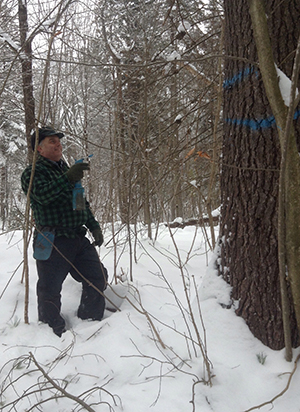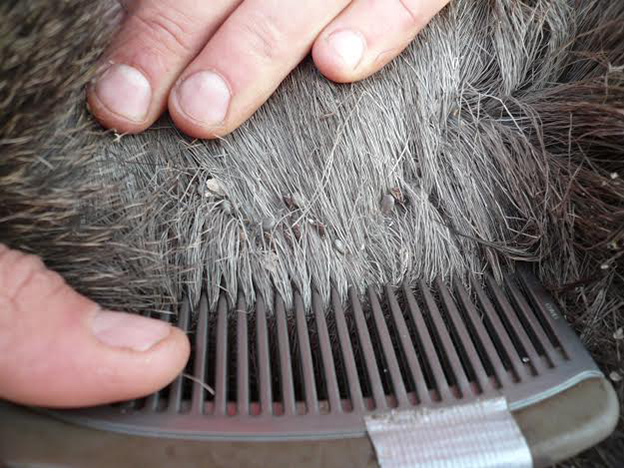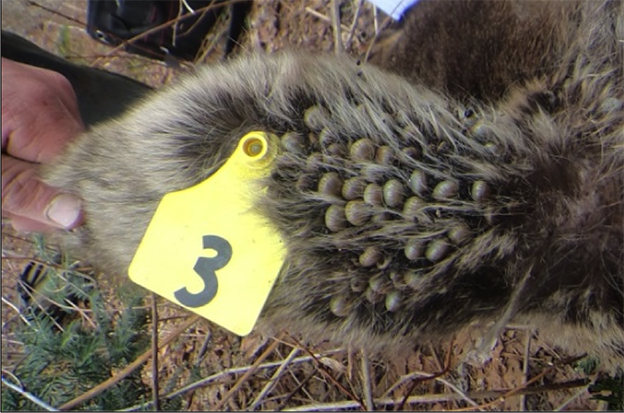 The following story was written by Ursula Jongebloed, a first-year Dartmouth College student who frequently leads trips in the Northeast with the Dartmouth Outing Club. Ursula is originally from Menlo Park, California, and has friends from all over the country who have been diagnosed with Lyme disease after being bitten by ticks during outdoor adventures.
The following story was written by Ursula Jongebloed, a first-year Dartmouth College student who frequently leads trips in the Northeast with the Dartmouth Outing Club. Ursula is originally from Menlo Park, California, and has friends from all over the country who have been diagnosed with Lyme disease after being bitten by ticks during outdoor adventures.
Each year during winter term, the Dartmouth Outing Club leads a weekend outing to the Second College Grant, a 27,000-acre area of wilderness given to the college by the state of New Hampshire in 1807. On the last night of the trip, the thirty students gather around a wood stove in the center of a log cabin to listen to older members of the Dartmouth Outing Club speak. This year, the speaker was Kevin Evans, the Director of Woodlands Management for Dartmouth’s Second College Grant.
 In the middle of February in cold, snowy New Hampshire, the wilderness feels like an unrelenting and immutable power over which humans could have little influence. And any sense of assuredness in the invincibility of nature was further dispelled as Kevin Evans spoke in front of the wood stove. Kevin’s main job is to make sure that Dartmouth’s logging practices are ecologically sound, which includes monitoring the welfare of the wildlife in the Grant. One of the animals for which Evans is most concerned is the moose. In recent years, the tick population, which feeds on the weakening moose population, has boomed.
In the middle of February in cold, snowy New Hampshire, the wilderness feels like an unrelenting and immutable power over which humans could have little influence. And any sense of assuredness in the invincibility of nature was further dispelled as Kevin Evans spoke in front of the wood stove. Kevin’s main job is to make sure that Dartmouth’s logging practices are ecologically sound, which includes monitoring the welfare of the wildlife in the Grant. One of the animals for which Evans is most concerned is the moose. In recent years, the tick population, which feeds on the weakening moose population, has boomed.
Kevin Evans hires a team to capture moose and count the number of ticks on each animal. The team calculates the number of ticks by taking four 10 cm transects and extrapolating the total number of ticks. When the team finds more than fifty ticks per square inch on the moose — which can translate to 40,000-60,000 ticks on the entire body — they know that the moose will not survive the winter.

At the end of the winter, the team assesses individual moose and the overall health of the population. They often find that dead moose have over 40,000 ticks on a single animal, a significant factor in the animal’s weakening and eventual death. The ticks feed on the moose’s blood, causing anemia, and severely depleting the moose’s nutrients.
According to the National Wildlife Federation, ticks accounted for 41% of all moose deaths in the state of New Hampshire over a five-year period. In 2014, 64% of moose died because of ticks, and the rate of tick-related death is rising.
When asked about the cause of the growing tick population, Kevin Evans explained, “We think that it is related to climate change.” Warmer winters make tick survival easier because the ground does not freeze early enough, which allows the snow to become a protective layer of insulation. Ticks latch onto moose and survive, breed, and continue the cycle.

Evans and other forestry experts worry about what will happen as the climate warms, the number of ticks grows, and the moose population falters. [See ‘A North Woods Icon at Risk”.]
He explains the impact of early snow and late snow:
“Winter larva ticks are in clumps on the vegetation questing for a host from September until there is lasting measurable snow with temperatures averaging <32 degrees Fahrenheit. If winter (snow and cold) comes late, then winter ticks have a longer time to quest and attach to moose, thus increasing tick loads on moose. Most engorged adult female winter ticks will fall off moose over an 8-week period in March and April. If these engorged females fall onto snow they are less likely to survive and if they do survive, they will likely be in poorer condition and thus lay fewer eggs. But if the snow pack leaves early, then we expect higher engorged adult female tick survival to egg laying and more eggs laid.
Shorter winters during the past few years likely built up the tick populations to the high levels seen in winter 2013/2014 and now 2014/1015. Based on last year’s later snow pack we expected lower tick loads this year, however that has not been true, at least in southern Coos county. There are several potential explanations for this discrepancy: 1) it takes a couple of longer winters to reduce winter tick populations, 2) moose density is a much more influential driver of winter tick populations than weather, or 3) our assumptions of winter length and tick numbers are not correct. Tick numbers in future years will be telling.”
****
References:
Musante, Anthony R., Peter J. Pekins, and David L. Scarpitti, “Metabolic Impacts of Winter Tick Infestations on Calf Moose,” ALCES, v. 43: 101-110, 2007 : Documents the energy costs and related health impacts associated with blood loss due to winter tick infestations on North American calf moose.
Samuel, William M. and Dwight A. Welch, “Winter Ticks on Moose and Other Ungulates: Factors Influencing their Population Size,” ALCES, v. 27: 169-182, 1991